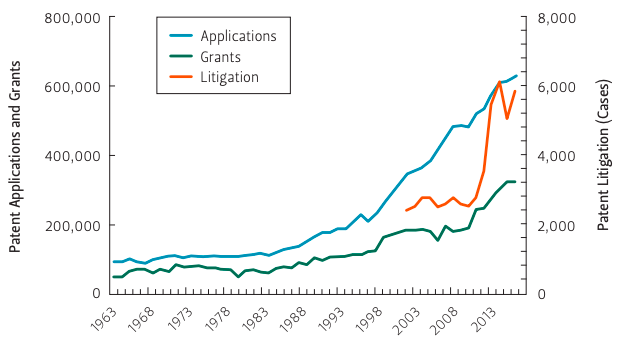The Next Engine of U.S. GDP Growth: The Market for Ideas

Table of Contents
Author(s)
Edward J. Egan
Former Fellow | Former Director, McNair Center for Entrepreneurship and InnovationShare this Publication
- Download PDF
- Print This Publication
- Cite This Publication Copy Citation
Egan, Edward J. 2016. The Next Engine of U.S. GDP Growth: The Market for Ideas. Policy Brief: Recommendations for the New Administration. Rice University’s Baker Institute for Public Policy, Houston, Texas.
The U.S. economy has undergone a fundamental shift in structure in the last three decades toward becoming an innovation economy. This shift has created enormous untapped potential, which can only be realized by learning to trade in ideas. But rather than advancing and adopting policies to promote this new driver of economic growth, U.S. policymakers have continued to live in a pre-innovation economy paradigm and are considering legislation that would hamper the market for ideas.
Innovation, loosely defined, is invention followed by commercialization. Trade in inventions leads to more efficient and wider-ranging commercialization, and is made vastly easier when inventions are associated with property rights, particularly patents.
Renewing the Foundation for Growth
U.S. GDP is currently $18.4 trillion, with a real growth rate of 1.1%.1 Using estimates from the economic literature, a mature market for patents could generate 5% additional annual growth for the U.S.—that is, this one market could single-handedly restore GDP growth back to levels last seen in the 1980s.2
Unfortunately, the first crucial foundation for the market for ideas—the patent office—is drastically underfunded.
There are currently around 2.5 million active patents available to be traded, with likely around 1 million patents caught in the U.S. Patent and Trademark Office (USPTO) backlog. The average time needed to process a patent application peaked at around 3.5 years before the introduction of the America Invents Act (AIA) in 2011 and now stands at just over 2 years.3
The USPTO spends an average of just 18 hours per patent application. Lemley argues that there should be a balance between expending resources in reviewing applications and allowing the courts to address problematic patents.4 But given pervasive claims of excessive patent litigation, reports that between one-third and one-half of all litigated patents are found invalid, the backlog of patent applications, and the low level of review by patent examiners, it is likely that patent quality is inefficiently low.
Figure 1 — Patent Grants, Applications and Litigation (1963–2015)

The USPTO’s budget request for 2017 is around $3.3 billion. But, unlike other federal agencies, the USPTO is not supported by appropriations. The USPTO collects its budget in fees and then must ask Congress if it can keep them.5 Each year, the U.S. spends half a trillion dollars on research and development, but the government does not spend a cent to provide inventors with high-quality, tradable property rights.6
Current Legislation Hinders Growth
The majority of large high-technology firms are publicly traded, have a short-term focus, and view patents as more of a costly nuisance than the long-term foundation of their business. Perhaps in response to lobbying from this group, bills like H.R. 9 “The Innovation Act,” S. 1137 “PATENT Act,” H.R. 2045 “Targeting Rogue and Opaque Letters Act of 2015,” and H.R. 1832 “Innovation Protection Act” have been introduced before the 114th Congress. Each of these bills intentionally weakens the enforcement of patents, making it easier to ignore and infringe them. Only S. 632 “STRONG Patents Act of 2015”7 is more balanced.
These bills often use patent trolls—those exerting patents in bad faith—as an excuse to make litigation harder and so infringement easier.8 Meanwhile, patent owners legitimately exerting their patents are having their rights curtailed, and patent intermediaries, who act as market makers for the market for ideas, are discouraged from entry. The second crucial foundation of the market for ideas—the ability to trade in patents—is being undermined.
Conclusion
A market for ideas encourages specialization in invention, matches inventions to their most efficient forms of commercialization, and broadens the range of products available to consumers. It is also an economic force in and of itself that may be capable of singlehandedly restoring U.S. prosperity.
To harness the power of the market for ideas, the U.S. must do two things: it must fund the patent office to 21st century levels, and it must bring the market for ideas out from behind closed doors in a way that enhances, rather than curtails, the rights of patent owners. Pushing crippling regulation onto this nascent free market will sacrifice one of America’s best hopes for growth in the new economic era.
Endnotes
1. See U.S. Bureau of Economic Analysis.
2. See Jay Walker, “The Real Patent Crisis Is Stifling Innovation,” Forbes, June 18, 2014. The article quotes a Forester Research report that states: “U.S. firms annually waste $1 trillion [about 5.5% of GDP] in underused intellectual property assets by failing to extract the full value of that property through partnerships.” Also see “How do you find a manufacturer to license your product?” U.S. News & World Report, June 10, 2002, which states that $120 billion of licensing activity took place in 2002. If this value has increased with inflation, and any increase has surely been much more dramatic, this would be 0.85% of today’s GDP.
3. See https://www.uspto.gov/aia_implementation/bills-112hr1249enr.pdf.
4. Mark Lemley, “Rational Ignorance at the Patent Office,” Northwestern University Law Review 95, no. 4 (2000).
5. Section 22 of the AIA allowed the patent office to deposit excess fees into a reserve fund, which would be available for use in the event of a government shutdown. Prior to the introduction of the AIA, the Congressional Research Service estimated that Congress had diverted more than $1 billion of the patent office’s fees between 1990 and 2011. See Glenn J. McLoughlin, “U.S. Patent and Trademark Office Appropriations Process: A Brief Explanation,” Congressional Research Service (7-5700, RS20906), 2014.
6. “Research and development (R&D)—Gross domestic spending on R&D—OECD Data” at data.oecd.org.
7. See https://www.govtrack.us/congress/bills/114/s632/summary.
8. There is scant evidence that patent trolls are a systematic problem. The courts, the Federal Trade Commission, and the Department of Justice have been aggressively pursuing instances of patent trolling. See, for example, Joe Mullin, “In a first, East Texas judge hits patent troll with attorneys’ fees,” ARS Technica, Dec. 20, 2015.
This material may be quoted or reproduced without prior permission, provided appropriate credit is given to the author and Rice University’s Baker Institute for Public Policy. The views expressed herein are those of the individual author(s), and do not necessarily represent the views of Rice University’s Baker Institute for Public Policy.


